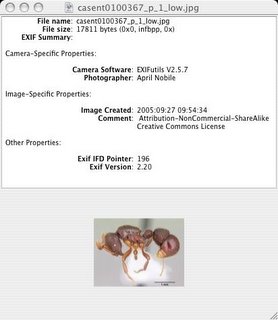Silobreaker looks to be a very cool way of exploring information. Facetted browsing is an old idea, but this looks like it might actually make it fun.
(Via Really Simple Sidi (RSS).)
A record of the development of the iSpecies search engine.
Silobreaker looks to be a very cool way of exploring information. Facetted browsing is an old idea, but this looks like it might actually make it fun.
(Via Really Simple Sidi (RSS).)
# AcceptPathInfo On is for Apache 2.x, don't use for Apache 1.x
<Files uri>
# AcceptPathInfo On
ForceType application/x-httpd-php
</Files>
<Directory "/Users/rpage/Sites/iphylo">
Options Indexes MultiViews
AllowOverride FileInfo
Order allow,deny
Allow from all
</Directory>
<?php
// Parse URL to extract URI
$uri = $_SERVER["SCRIPT_URL"];
$uri = str_replace ($_SERVER["SCRIPT_NAME"] . '/', '', $uri);
// Check for any prefixes, such as "rdf" or "rss" which will flag the
// format to return
// Check that it is indeed a URI
// Lookup in our database
// Display result
?>

File name: casent0100367_p_1_low.jpg
File size: 17811 bytes (0x0, infbpp, 0x)
EXIF Summary:
Camera-Specific Properties:
Camera Software: EXIFutils V2.5.7
Photographer: April Nobile
Image-Specific Properties:
Image Created: 2005:09:27 09:54:34
Comment: Attribution-NonCommercial-ShareAlike Creative Commons License
Other Properties:
Exif IFD Pointer: 196
Exif Version: 2.20
I searched on Solenopsis invicta and thought the return information was great.
The biodiversity community is one group working to develop such services. To demonstrate the principle, Roderic Page of the University of Glasgow, UK, built what he describes as a "toy" — a mashup called Ispecies.org (http://darwin.zoology.gla.ac.uk/~rpage/ispecies). If you type in a species name it builds a web page for it showing sequence data from GenBank, literature from Google Scholar and photos from a Yahoo image search. If you could pool data from every museum or lab in the world, "you could do amazing things", says Page.
This is too cool - some interesting examples of "Scientific mashups" from Richard Akerman. I followed the iSpecies link and was blown away by the data that was returned. I studied a damselfly called Argia vivida for my graduate degree and way back then finding data on the bug was not always easy. Searching the species in iSpecies bring up a TaxID number to the NCBI Taxonomy Browser, a list of papers from Google Scholar and images from Yahoo Images. This is an excellent example of what we have all been waiting for with the promise of the Web and web services in particular. The concept of a page for every species known is a dream come true for science, so this one is worth watching.
iSpecies is a nice example of a science "mashup" that illustrates an alternative search interface for finding related content. I used the false results that can appear when performing simple keyword searches to reinforce the need for standard identifiers. (The need for a common, scoped identifier for authors, is a particular hobby horse of mine).
What is also cool is that each species has RDF formated metadata associated with it via an LSID, see here for an example. It would be nice if each species had its own permanent URL, which would be arguably more useful than an LSID, but I won't go there :)